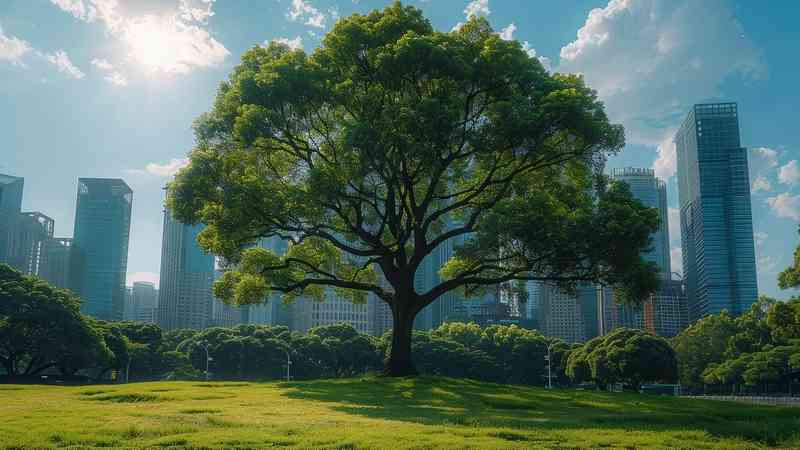Trees have played a central role in the development of human civilization and the balance of natural ecosystems. They provide oxygen, regulate temperatures, preserve soil, and support biodiversity in ways that no artificial system can replicate. As societies face increasing environmental challenges, trees are becoming even more valuable in ensuring a sustainable future for all living beings.
This article explores the many roles trees play in ecology, the economy, and human well-being, offering guidelines for protecting and preserving them.
The Ecological Role of Trees
Oxygen Production and Air Quality
One of the most important contributions of trees is their ability to produce oxygen through photosynthesis. At the same time, they absorb carbon dioxide, a major greenhouse gas. This natural exchange makes forests vital in slowing climate change. In urban areas, trees improve air quality by filtering dust, pollutants, and harmful gases.
Soil Preservation and Water Cycle
Roots help bind soil, preventing erosion caused by wind and water. They also enhance the water cycle by increasing groundwater recharge and reducing surface runoff. Forests play a crucial role in maintaining rivers, streams, and underground aquifers, which sustain both agriculture and human settlements.
Biodiversity and Habitat Creation
Forests provide shelter for countless species of animals, insects, fungi, and microorganisms. Trees create complex habitats where diverse species can coexist, ensuring the stability of global biodiversity. Without them, many species would face extinction.
The Economic Value of Trees
Timber and Non-Timber Products
Trees are a source of timber used in construction, furniture, and countless manufactured goods. Beyond wood, they also produce fruits, nuts, resins, and medicinal products. These non-timber resources often provide income to rural communities while maintaining forest cover.
Climate Resilience and Agricultural Support
Trees enhance agricultural productivity by acting as windbreaks, providing shade, and enriching the soil with organic matter. Agroforestry systems, where trees are integrated with crops, are proven to improve yields and make farming more climate resilient.
Urban Development and Real Estate
The presence of trees in cities adds not only aesthetic value but also financial worth to properties. Green neighborhoods are more desirable, raising housing values while simultaneously improving the quality of life for residents.
Trees and Human Health
Mental Health and Well-being
Scientific studies show that spending time near trees reduces stress, anxiety, and depression. Exposure to green environments has been linked to improved mood, creativity, and overall mental health.
Physical Health Benefits
Trees filter pollutants, reducing respiratory problems such as asthma. Urban green spaces encourage walking, jogging, and outdoor activities, promoting healthier lifestyles.
Social and Cultural Importance
Throughout history, trees have held symbolic meanings in religions and traditions. They often represent life, wisdom, and endurance. Sacred groves and cultural rituals highlight how deeply human societies are connected to nature.
Environmental Challenges Facing Trees
Deforestation
Large-scale deforestation caused by logging, agriculture, and infrastructure development remains a major global issue. The loss of forests leads to reduced biodiversity, soil degradation, and climate imbalance.
Climate Change
Rising temperatures, extreme weather events, and shifting rainfall patterns are affecting forest ecosystems. Some species of trees are struggling to adapt, resulting in habitat loss and declining populations.
Urbanization
As cities expand, natural green areas are often replaced by concrete structures. Urban deforestation not only reduces greenery but also increases the “heat island effect,” raising temperatures in cities.
Guidelines for Protecting and Preserving Trees
Promote Sustainable Forestry
Forest management practices should prioritize selective logging, replanting, and protecting endangered species. Governments and communities must work together to balance economic needs with environmental conservation.
Encourage Urban Green Spaces
City planners should integrate parks, roadside trees, and rooftop gardens into urban landscapes. Planting more greenery in cities improves air quality and reduces heat, making urban life healthier.
Community Engagement and Education
Raising awareness about the value of trees helps build collective responsibility. School programs, awareness campaigns, and local initiatives can inspire communities to protect their green surroundings.
Individual Action
Every person can contribute by planting and caring for trees in their homes, neighborhoods, and workplaces. Supporting sustainable products and reducing paper waste also helps decrease pressure on forests.
The Future of Trees and Global Sustainability
Trees are not only vital for ecosystems but also for the survival of humanity. Their role in combating climate change, supporting economies, and enhancing human well-being makes them central to global sustainability goals. By adopting responsible practices and prioritizing conservation, societies can ensure that trees continue to support life for generations to come.
Conclusion
Trees are more than just natural resources—they are guardians of the planet’s balance. From regulating climate to supporting biodiversity and human health, their contributions are immeasurable. Protecting them requires global cooperation, local initiatives, and individual responsibility. As humanity moves toward a more sustainable future, trees will remain one of the most powerful allies in preserving life on Earth.

